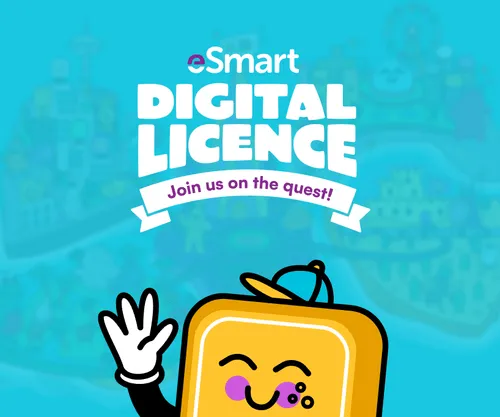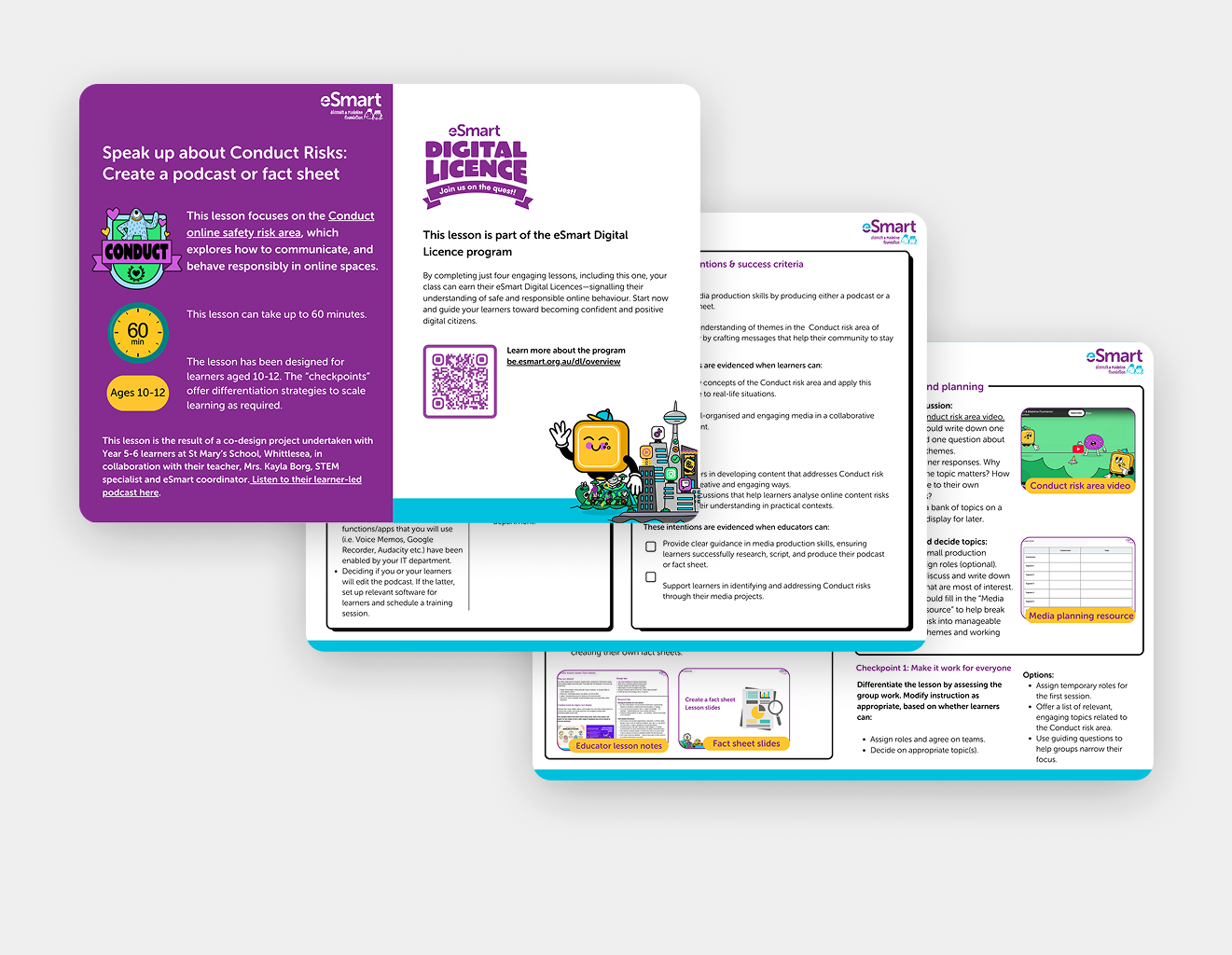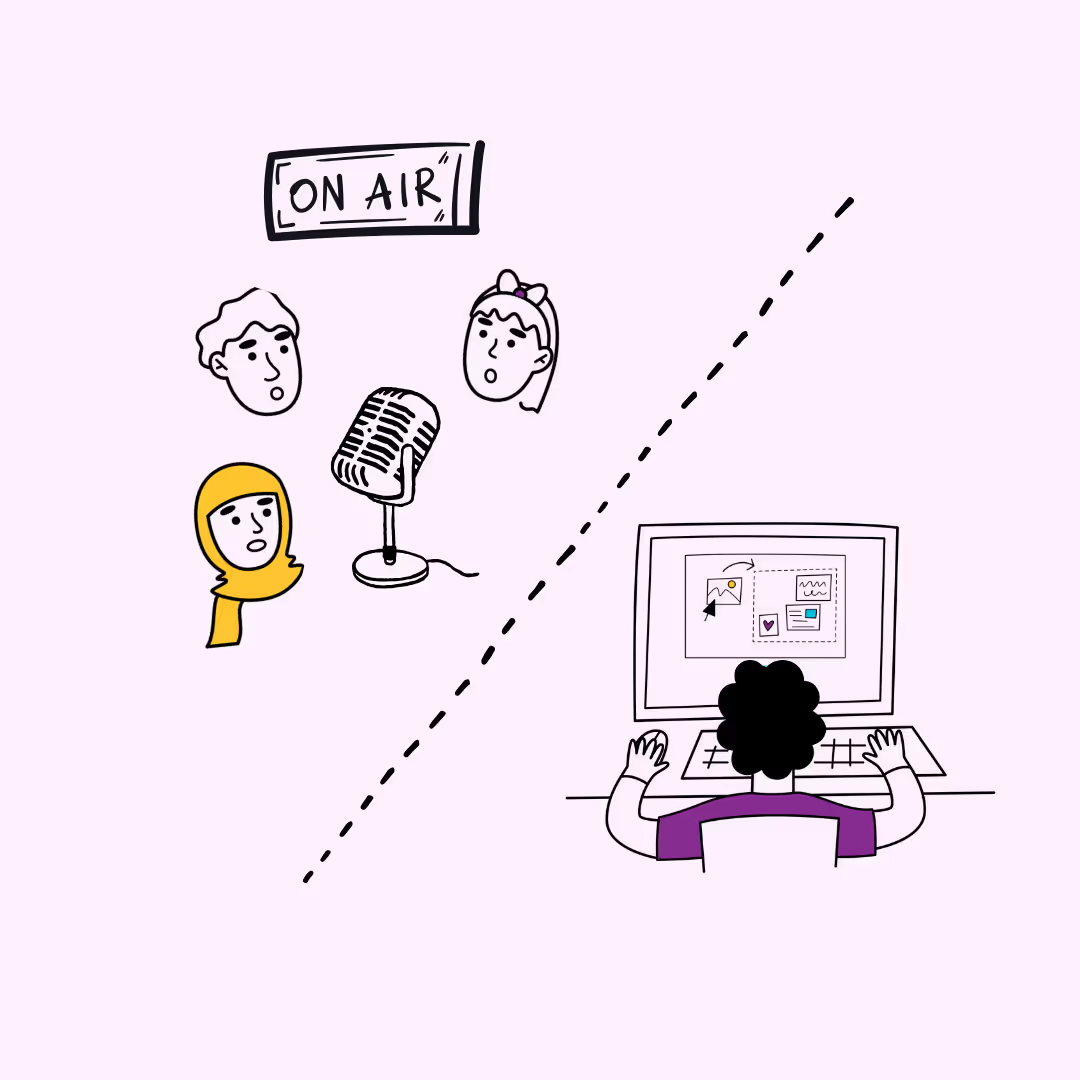Download Lesson Pack
Speak Up About Conduct Risks: Create a Podcast or Fact Sheet

Child Safeguarding Statement
Some resources and activities may prompt a child to remember and potentially share an experience of harm. Make sure you’re familiar with your school's safeguarding policies and procedures so you can confidently report safety and well-being concerns.
Prepare students for the session by discussing: their right to be safe and respected; what to do if discussing online safety makes them feel uncomfortable or unsafe; and how to seek help if they feel or have felt unsafe. Use this resource available on the website.
Speak Up About Conduct Risks: Create a Podcast or Fact Sheet
Empowering learners to explore online conduct risks through podcast creation or fact sheet design.
Lesson details
Conduct
About this Risk Area
The behaviour children and young people engage in online.
Example topics:
- Cyberbullying awareness and prevention strategies.
- Practicing kindness, empathy, and respectful communication online.
- Understanding the consequences of digital actions, including what can be deleted and what cannot be deleted.
- Respecting online community guidelines and fostering a positive online environment.
The resources for this risk area guide positive online behaviours, by promoting kindness, respect, and responsible digital citizenship.
This lesson helps learners explore the "Conduct" risk area of online safety — understanding safe, respectful, and responsible online behaviour. Topics may include managing online conflicts, recognising inappropriate behaviour, and understanding the impact of digital actions on themselves and others. It is the result of a co-design project undertaken with Year 5-6 learners at St Mary’s School, Whittlesea, in collaboration with their teacher, Mrs. Kayla Borg, STEM specialist and eSmart coordinator. Listen to their learner-led podcast here.
The class may choose to either:
Create a podcast:
Develop skills in research, scripting, and interviewing to produce a podcast on a topic relevant to the "Conduct" risk area.
OR
Design a fact sheet:
Craft an informative guide to share helpful tips and insights with their community relevant to the "Conduct" risk area.
Learning Intentions
Learners will:
- Develop media production skills by producing either a podcast or a digital fact sheet.
- Apply their understanding of themes in the "Conduct" risk area of online safety by crafting messages that help their community to stay safe online.
These intentions are evidenced when learners can:
- Explain key concepts of the "Conduct" risk area of online safety, and apply this knowledge to real-life situations.
- Create well-organised and engaging media in a collaborative environment.
Educators will:
- Guide learners in developing content that addresses Conduct risk themes in creative and engaging ways.
- Facilitate discussions that help learners analyse online content risks and apply their understanding in practical contexts.
These intentions are evidenced when educators can:
- Provide clear guidance in media production skills, ensuring learners successfully research, script, and produce their podcast or fact sheet.
- Support learners in identifying and addressing Conduct risks through their media projects.
Curriculum alignment
Australian Curriculum (Version 9.0)
The Australian Curriculum outlines the fundamental knowledge, comprehension, and abilities students are expected to acquire as they advance through the initial 11 years of schooling.
Podcasting
Years 5 & 6: Health and Physical Education
- AC9HP6P08: Analyse and rehearse protective behaviours and help-seeking strategies that can be used in a range of online and offline situations.
- AC9HP6P10: Analyse how behaviours influence the health, safety, relationships and wellbeing of individuals and communities.
- AC9HP6M06: Propose and explain strategies to increase physical activity and reduce sedentary behaviour levels in their lives.
Years 5 & 6: Media Arts
- AC9AMA6D01: Develop media production skills to communicate ideas, perspectives and/or meaning through manipulation of media languages, including images, sounds, texts and/or interactive elements, and media technologies
- AC9AMA6C01: Use media languages, media technologies and production processes to construct media arts works that communicate ideas, perspectives and/or meaning for specific audiences
Year 5: English
- AC9E5LA02: Understand how to move beyond making bare assertions by taking account of differing ideas or opinions and authoritative sources.
- AC9E5LY02: Use appropriate interaction skills including paraphrasing and questioning to clarify meaning, make connections to own experience, and present and justify an opinion or idea.
- AC9E5LY05: Use comprehension strategies such as visualising, predicting, connecting, summarising, monitoring and questioning to build literal and inferred meaning to evaluate information and ideas.
Year 6: English
- AC9E6LY02: Use interaction skills and awareness of formality when paraphrasing, questioning, clarifying and interrogating ideas, developing and supporting arguments, and sharing and evaluating information, experiences and opinions.
- AC9E6LY05: Use comprehension strategies such as visualising, predicting, connecting, summarising, monitoring and questioning to build literal and inferred meaning, and to connect and compare content from a variety of sources.
Fact sheets
Years 5 & 6: Health and Physical Education
- AC9HP6P08: Analyse and rehearse protective behaviours and help-seeking strategies that can be used in a range of online and offline situations.
- AC9HP6P10: Analyse how behaviours influence the health, safety, relationships and wellbeing of individuals and communities.
- AC9HP6M06: Propose and explain strategies to increase physical activity and reduce sedentary behaviour levels in their lives.
Years 5 & 6: Digital Technologies
- AC9TDI6P07: Select and use appropriate digital tools effectively to create, locate and communicate content, applying common conventions.
- AC9TDI6P08: Select and use appropriate digital tools effectively to share content online, plan tasks and collaborate on projects, demonstrating agreed behaviours.
Year 5: English
- AC9E5LA02: Understand how to move beyond making bare assertions by taking account of differing ideas or opinions and authoritative sources.
- AC9E5LY05: Use comprehension strategies such as visualising, predicting, connecting, summarising, monitoring and questioning to build literal and inferred meaning to evaluate information and ideas.
Year 6: English
- AC9E6LA02: Understand the uses of objective and subjective language, and identify bias.
- AC9E6LA07: Identify and explain how images, figures, tables, diagrams, maps and graphs contribute to meaning.
- AC9E6LY03: Analyse how text structures and language features work together to meet the purpose of a text, and engage and influence audiences.
- AC9E6LY05: Use comprehension strategies such as visualising, predicting, connecting, summarising, monitoring and questioning to build literal and inferred meaning, and to connect and compare content from a variety of sources.
My Time, Our Place – Framework for School Age Care in Australia
This framework assists educators to provide children and young people with opportunities to maximise their potential and develop a foundation for successful lifelong learning. The Framework has been designed for use by approved providers and school age care educators working in partnership with children and young people, their families and the community, including schools.
Outcome 1: Children have a strong sense of identity.
Children develop confidence in their ability to interact positively with others in online spaces by understanding the values that underpin respectful and collaborative teamwork. This is evident when children:
- Reflect on how their behaviour in online spaces demonstrates their personal values and principles.
Outcome 2: Children are connected with and contribute to their world.
Children explore how positive online behaviour contributes to building respectful and cooperative digital communities. This is evident when children:
- Recognise the importance of rules and codes of conduct in creating safe and supportive digital spaces.
Outcome 5: Children are effective communicators.
Children use their knowledge of teamwork values and digital etiquette to communicate effectively and build positive relationships in online environments. This is evident when children:
- Use appropriate language and strategies to resolve conflicts and support others in online spaces.
CASEL Framework
This Framework creates a foundation for applying evidence-based, Social and Emotional Learning (SEL) strategies both at school and in the broader community. Its aim is to support the cultivation of SEL skills and environments that advance students’ learning and development.
Self-Awareness
The lesson helps learners reflect on their own values and how they influence behavior in online spaces.
This is evident when learners:
- Identify their personal strengths and values, such as respect, kindness, and fairness.
- Reflect on how their behaviour in digital spaces demonstrates these values.
- Recognise how their contributions to teamwork affect the overall dynamic of online interactions.
Bournemouth University Theory of Change
This project, funded by the Department for Digital, Culture, Media and Sport (DCMS) as part of the UK government's Online Literacy Media Strategy, aims to empower people to stay safe online by being able to critically evaluate what they see and read on the internet. It offers a transferable and sustainable framework and methodology that can not only be used for the independent evaluation of media literacy projects but also to inform their future design.
Capabilities
This is where we use our media literacy more actively for particular purposes in our lives, rather than as passive consumers of information and content. Media literacy capabilities range from access changes, the application of more critical or mindful decision making when receiving information, the use of fact-checking of information or sources, more informed attitudes to sharing content and information, or getting directly involved in the media ecosystem as creators of media content.
National Association of Media Literacy Education (NAMLE)
The NAMLE Framework outlines the foundational concepts and principles for teaching and learning about media literacy. Media literacy, as defined by NAMLE, is the ability to access, analyze, evaluate, create, and act using all forms of communication.
Core Principle 1
- 1.1: MLE encourages learners to ask critical questions about the media they engage with.
- 1.2: MLE intersects with other literacies, such as social and emotional literacy.
Core Principle 2
- 2.1: MLE encompasses digital, social, and interactive media.
- 2.3: MLE integrates emotional and physiological responses to media.
Core Principle 3
- 3.1: MLE equips learners with transferable skills for analysing and creating positive online interactions.
Core Principle 4
- 4.1: MLE helps learners understand the social norms and values promoted through media.
- 4.3: MLE examines the role of media in shaping behaviour and expectations.
Core Principle 6
- 6.1: MLE promotes responsible and ethical behaviour in online interactions.
- 6.3: MLE encourages collaborative problem-solving and dialogue.



.png)
.png)



.avif)
.avif)